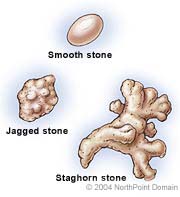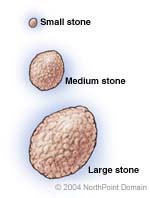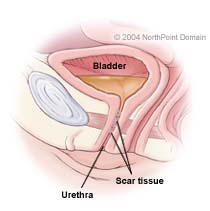Bladder Stones
Basic Facts
- Bladder stones usually are caused by bladder outlet obstructions, which cause retained urine.
- Bladder stones are hardened, rock-like accumulations that form from mineral salts that occur naturally in urine.
- Untreated, stones may block the flow of urine, leading to serious complications, including damage to the bladder, kidneys, uremic poisoning, and even death.
 Urinary stones or calculi are hardened, rocklike accumulations that form from naturally occurring mineral salts in the urine. Small, undissolved crystals accumulate and begin to clump together. Most calculi are small enough that they never cause any problem. Occasionally, however, they stick to the inner lining of the kidney or ureter and continue to increase in size as additional crystals in the urine become attached. In the United States, bladder stones usually occur in men older than age 50 who have some type of bladder obstruction, such as an enlarged prostate gland.
Urinary stones or calculi are hardened, rocklike accumulations that form from naturally occurring mineral salts in the urine. Small, undissolved crystals accumulate and begin to clump together. Most calculi are small enough that they never cause any problem. Occasionally, however, they stick to the inner lining of the kidney or ureter and continue to increase in size as additional crystals in the urine become attached. In the United States, bladder stones usually occur in men older than age 50 who have some type of bladder obstruction, such as an enlarged prostate gland.
Often bladder stones form in the kidneys, and for this reason they are sometimes referred to as kidney stones. Stones can develop from different kinds of materials in the body, including:
- Calcium oxalate or cystine;
- Uric acid; and
- Struvite
WHAT ARE THE SYMPTOMS?
Bladder stones can cause a variety of symptoms, which include:
- Dark urine;
- Difficulty urinating;
- Strong, frequent urges to urinate;
- Burning sensation during urination;
- Blood in the urine;
- Interrupted urine stream;
- Discomfort or pain in the male genital area;
- Pain in the back, hips, or foot; and
Incontinence.
Other symptoms may appear because of an infection promoted by the stone. They include:
- Chills and fever;
- Cloudy or foul-smelling urine; and
- Extremely painful urination.
 CAUSES AND RISK FACTORS
CAUSES AND RISK FACTORS
Bladder stones usually result from other problems that block urine flow. The most common causes are:
- Prostate enlargement in men;
Urethral stricture, an unusual narrowing of the urethra; - Recurring or chronic urinary infections;
- Bladder diverticulum, a small sack that forms in the wall of the bladder and traps particles; and
- Neurogenic bladder, a nerve disorder that can cause urine retention.
The following surgical procedures increase the risk of bladder stones:
- Surgery to correct incontinence (in women);
- Augmentation cystoplasty, a procedure that reconstructs a dysfunctional bladder with bowel tissue and can lead to urinary infections; and
- Kidney transplants, because of the likelihood of urinary infections.
DIAGNOSIS
Often bladder stones are discovered in the course of a medical examination conducted to investigate other urinary conditions, such as urine retention or neurogenic bladder. The following tests may also be ordered:
- Digital rectal examination (in men) to determine whether the cause is an enlarged prostate); and
- Urinalysis to determine if infection is present and if there is blood in the urine.
Next the physician will try to locate the stone and determine its size. He or she may order the following tests:
- Intravenous pyelogram (A medical dye is injected into the bloodstream to provide visual contrast of the bladder for x rays.)
- Ultrasound
- Cystoscopy (A physician inserts a telescope into the urethra to view the inside of the bladder.)
TREATMENT APPROACH
All urinary stones should be treated to avoid serious, even life-threatening, complications.
Most small stones eventually exit the body on their own. For this reason, a patient with small stones is usually instructed to drink as much fluid as possible to help flush out the stone.
If necessary, the physician can remove the stone using a cystoscope or other instrument inserted in the urethra. Another option, lithotripsy, creates sound waves outside the body to pulverize the stones inside the body.
The physician may also recommend treating underlying conditions associated with bladder stones. For example, prostate enlargement can be treated with transurethral resection of the prostate, or TURP, a surgical procedure that shaves away layers of prostate tissue.
Copyright © 2021 NorthPoint Domain, Inc. All rights reserved.
This material cannot be reproduced in digital or printed form without the express consent of NorthPoint Domain, Inc. Unauthorized copying or distribution of NorthPoint Domain’s Content is an infringement of the copyright holder’s rights.
